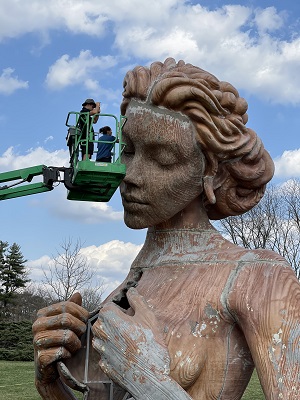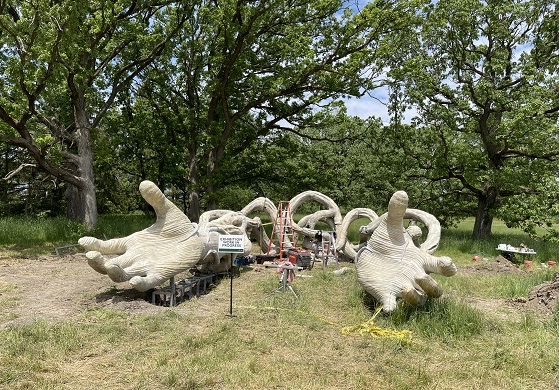One of the things I like most about my job is diversity. One day we’ll be working on the interior lining system for a sour water tank at a refinery, and the next day I’ll be on a flight to New York to inspect some mysterious corrosion on a variety of stainless-steel swimming pools and spas.
And then, even more distinct, was this project. The statue is called “Thrive,” and it is the creation of the South African artist Daniel Popper. (Remember his name, as I predict it will become more and more familiar over time, as his work enthralls the world.) It’s about 30 feet (9.1 m) tall and features a woman’s face split in two.
Popper’s works are substantially larger than life. They intertwine nature and a sense of organic structure, which is simply moving to behold in person. Also noticeable in person was a coatings challenge.
Distress Call
On my first meeting with Popper and his team, we found that Thrive needed a serious makeover.
We met at The Morton Arboretum in Lisle, Ill., which sits upon more than 1,700 acres of verdant, rolling Midwest soil about 30 minutes southwest of Chicago. Popper was commissioned to erect five spectacular, giant-sized, outdoor sculptures for a three-year exhibit.
Popper’s process for these sculptures was new: This was the first time that he had some of concrete pieces built and shipped from China. That is, he designed molds; used a specialized, fiber-reinforced concrete; had them built in China; and shipped them to the Arboretum. He also had the concrete components painted in China as well.
The problem was, however, that as the team unpacked the pieces for Thrive, they noted that the paint was in serious distress. The paint was peeling and exhibited intercoat delamination, as well as disbondment from the substrate. Popper and his team started using hand tools to remove the distressed paint, only to find that the going was slow, inefficient, and tedious.
Here’s why.
Time and Methods
 There were several challenges, starting with time. Popper had a small crew from South Africa, and they had to assemble and complete four other sculptures in addition to Thrive. They couldn’t do it all at the same time. Second, with me on site, we needed to figure if we were going to try to scrape and patch the distressed paint, or remove it all. Third, when putting the segments together, there would be seams that needed to be hidden and incorporated into the sculpture with specialized lightweight concrete. Fourth, in addition to repairing the seams, Popper needed to be able to apply the lightweight concrete to various areas of the sculpture to impart nuance, wood grain, and other aesthetic touches that could not be captured with the molds in China.
There were several challenges, starting with time. Popper had a small crew from South Africa, and they had to assemble and complete four other sculptures in addition to Thrive. They couldn’t do it all at the same time. Second, with me on site, we needed to figure if we were going to try to scrape and patch the distressed paint, or remove it all. Third, when putting the segments together, there would be seams that needed to be hidden and incorporated into the sculpture with specialized lightweight concrete. Fourth, in addition to repairing the seams, Popper needed to be able to apply the lightweight concrete to various areas of the sculpture to impart nuance, wood grain, and other aesthetic touches that could not be captured with the molds in China.
In general, going over existing paint and coatings systems is something our firm recommends frequently — when technically warranted. I’ve found that there is a momentum — almost like gravity — for vendors, engineering firms, and others to choose to remove a coating system and replace it, rather than to perform the intellectual and technical rigor and evaluate if it can stay in place and be left alone, touched up, or overcoated.
On Thrive, however, a quick look at the repair and seaming concrete and paint indicated that all of the paint needed to be removed.
Mainly, it turned out that it wasn’t paint after all!
A Way Ahead
First, the repair concrete needed to be applied directly to bare concrete. In fact, in various areas where Popper needed to build up the concrete by several inches, the concrete needed to be ground, chiseled, or otherwise severely prepared in order for the new concrete to “bite” into the old.
Second, the paint Popper intended to use on the entire sculpture was not paint at all but a concrete stain, which is a completely different animal.
I had only worked with a concrete stain once, many years ago, as it is typically considered decorative and not in the realm of my usual work in dealing with protective coatings and paint systems.
Two phrases from the stain’s product data sheet told me immediately that we weren’t in Kansas anymore:
1. Great penetration into masonry surfaces.
2. Avoid excessive coats, which can build film.
In our paint and coatings realm, film is everything. In fact, it’s the only thing. We build film in order to provide aesthetics and protect whatever substrate we’re tasked with protecting.
Stains, however, are very, very thin, and they are typically translucent. They require multiple coats to provide different shades and appearances. This would be terrible for a paint job that strives for uniformity, but perfect when trying to capture the nuance of a beautiful woman’s face — especially when it’s the size of a small bus.
Excessive coats were a no-go, which meant that all of the paint needed to be removed in order to open the pores and capillaries of the concrete, so that Popper could share his vision with us.
We now knew what we needed to do — but how should we do it?
The Right Prep
While Popper and his team had started to remove the paint with hand tools, the going was slow and inconsistent. To me, this meant that abrasive blasting was certainly the way to go. But, what kind?
The sculpture was located off a couple of walking paths and near a small, manmade lake. And work could only take place during normal working hours.
Normal abrasive blasting is loud and dusty. Further, blasting aggregate (typically sand, coal slag, or similar) creates an enormous, ugly mess. That would require either tarping large areas of the grass or encasing the entire sculpture in a tarp of some kind — a possibility, but it was not optimal.
This is where that project diversity comes into play. I had worked on a project a few years earlier in one of the largest hotels in Chicago. It was a fountain in the main driveway of the hotel, and it was enclosed on all sides but the circular driveway, so dust would have been terribly problematic.
We had heard about fluidized blasting and floated the idea by a local vendor who had just purchased the specialized equipment. Unlike dry abrasive blasting (or wet abrasive blasting, which adds liquid water to the blast flow), water in a gas stage (aka vapor) replaces compressed air and can use many types of aggregates, similar to dry blasting. While loud as the dickens in this format, dust is reduced by more than 90 percent, and the production rate is nearly as high as dry abrasive blasting.
The contractor from the fountain job, who was a close working associate of mine, met the Thrive team two days later. He agreed to do the work within the next two days (in the rain, by the way), at his cost. We decided to use small glass beads as the aggregate because they were clear, environmentally safe, and disappeared on the grass and walking paths surrounding the sculpture. It was a win-win solution.
A Profound Outcome
On my first meeting with Popper and seeing Thrive before its makeover, I was stunned and moved at the sight of the sculpture. But after the artist and his team applied the various materials onto the properly prepared substrate, the change was surprising and profound. Despite the challenges, we found the right solution to bring this amazing piece of art to life in just the way that the artist had intended.

Our industry holds so many opportunities for the identification of optimal materials and practices; it remains a profound privilege to be a part of it.
About the Author:
 Warren Brand heads Chicago Corrosion Group, a leading vendor-neutral consultancy. Brand’s career has covered more than four decades. He has owned an industrial tank lining and coating firm and has written dozens of blogs and technical articles in a variety of publications. He has managed thousands of coating installation projects and developed specs for thousands of paint and coating applications. Brand, who is a certified NACE Level 3 and SSPC: The Society for Protective Coatings protective coating specialist (PCS), has earned an MBA and is a martial arts aficionado. For more information, contact: Warren Brand, warren@chicagocorrosiongroup.com
Warren Brand heads Chicago Corrosion Group, a leading vendor-neutral consultancy. Brand’s career has covered more than four decades. He has owned an industrial tank lining and coating firm and has written dozens of blogs and technical articles in a variety of publications. He has managed thousands of coating installation projects and developed specs for thousands of paint and coating applications. Brand, who is a certified NACE Level 3 and SSPC: The Society for Protective Coatings protective coating specialist (PCS), has earned an MBA and is a martial arts aficionado. For more information, contact: Warren Brand, warren@chicagocorrosiongroup.com